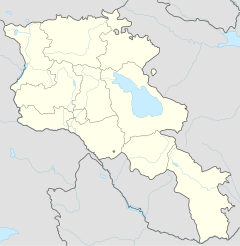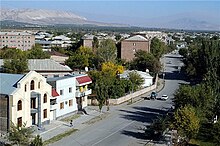Masis (city)
|
Masis Մասիս |
||
|
||
| State : |
|
|
| Province : | Ararat | |
| Coordinates : | 40 ° 4 ′ N , 44 ° 26 ′ E | |
| Height : | 854 m | |
| Time zone : | UTC + 4 | |
| Telephone code : | (+374) +374 (236) | |
| Community type: | city | |
| Mayor : | David Hambardsumjan ( HHK ) | |
| Website : | ||
|
|
||
Masis ( Armenian Մասիս ) is a city in the central Armenian province of Ararat , which is important as a goods transhipment point, train station and housing estate for the state capital of Yerevan, 14 kilometers to the northeast .
location
Masis is located at 854 meters above sea level in the broad valley of the Aras , the border river to Turkey, and on the left bank of the Hrasdan , which carries water from Lake Sevan , flows through a Yerevan gorge and flows into the Aras a few kilometers south of Masis. The alluvial plain south of the city is crossed by irrigation canals and is used intensively for agriculture. Vegetables (watermelons, tomatoes, aubergines), grapes and fruit trees, especially apricots and peaches, thrive on small-parceled fields. In numerous ponds between Masis and the villages of Ranchpar (six kilometers to the south) and Sayat Nova (four kilometers to the west), fish farming is carried out, as in other areas of the Macaw Plain, the yield of which is sold to the capital. In some villages there are problems with the drinking water supply, as too much water is drawn off from deeper and deeper artesian wells for the fish farming basins.
Masis can be reached from Yerevan on the M2, which has been developed as a motorway . At the motorway junction, the western exit leads to Masis; the M15 branches off to the east, which circles the city of Yerevan to the east from Masis via Nubaraschen to Abowjan . In the center of Masis, the H13 crosses between the neighboring villages of Marmaraschen in the east and Sayat Nova in the west with the H12, which leads south from the motorway exit to Ranchpur an der Aras. The nearest towns from Masis on the M2 to the southwest are Artaschat (14 kilometers) and Ararat (another 17 kilometers). Masis is also the name of one of the villages that have grown together in a long chain on the parallel road to the motorway from Artashat towards Yerevan.
history
At the beginning of the 20th century the district of Zangibasar with several Kurdish-Muslim villages was located here. During the Democratic Republic of Armenia , which existed between 1918 and 1920, attempts were made to drive out the insurgent Muslims. After an uprising fueled by the Bolsheviks in May 1920, which the Armenian government perceived as a conspiracy between the socialists and the Muslims living in the country, a military attack took place against the Muslim settlements in the districts of Zangibasar and Vedibasar, around the fertile and strategically important Aras valley to take. By July, the Armenian units had advanced into the Nakhichevan area and forced many Kurds and Azerbaijanis to flee.
In December 1937, a 160 square kilometer district of Zangibasar was created in the Armenian Soviet Socialist Republic from parts of the previous districts of Etchmiadzin and Artashat. Like the district, its 31 villages and settlements also had mostly Turkish names, so the majority of the inhabitants were Azerbaijanis. Around 1949 the Soviet administration gave up the district. The Soviet government distrusted the Azerbaijanis who lived directly on the Turkish border and ordered their resettlement from Zangibasar.
Masis was re-established as a city in 1950 for the subsequently settled Armenians. Masis is the Armenian name of Mount Ararat , which is just across the border and sacred to the Armenians . The historian Moses von Choren gives the origin of the name in the 5th century, which is handed down to this day as a folk etymology. According to this, Masis is derived from Amasia, a sixth generation descendant of Jafet , who survived the Flood as one of Noah's three sons . Amasia (today Amasya ) is also the ancient name of a city in Asia Minor. After three generations following Amasia, Aram was born, which became the foreign name for the Armenians who call themselves Hajer. At least that is how the Armenian historian Vardan Arevelci sums it up in the 13th century. In addition to Mount Ararat, two other mountains in historical Greater Armenia bear the name of Masis. The Nekh Masis (Nex Masis, pronounced "Nech Masis", today Süphan Dağı ) north of Lake Van, like the Ararat, clearly towers over the surrounding area and was therefore also associated with the Flood myth in early Christian times. Masis seems to be an Armenian loan word from Persian meaning "bigger", "huge".
Cityscape
According to official statistics, there were 22,138 inhabitants in Masis in January 2008. During the socialist era, Masis was an important railway junction on the route between the Georgian Soviet Republic in the north and the connection to Nakhichevan in the south, which was closed down by the Nagorno-Karabakh conflict around 1990 . A railway line branches off to the east to Yerevan and Lake Sevan. The train station is about two kilometers west of the center.
The streets of the city center were laid out in a largely uniform rectangular grid. The central intersection of the broad main streets with the marshrutkas stop is surrounded by the post office and other public buildings and some grocery stores. Agricultural products of the region in street sales are offered in smaller side streets. The central residential areas are characterized by five-storey, cheaply built apartment blocks from the socialist era, each with an average of 50 residential units. There are no sights.
At the edges, especially towards the south, the settlement structure becomes rural. Single-storey single-family houses that are surrounded by vegetable gardens spread out along unpaved roads before they turn into open fields. There are some wood processing industries, others produce paints and varnishes.
Personalities
- Edgar Stepanyan (* 1997 in Masis), racing cyclist
See also
Web links
- Rick Ney: Ararat marz. Tour Armenia, 2012, p. 16f
Individual evidence
- ↑ http://www.masiscity.am/Pages/DocFlow/Def.aspx?a=v&g=be052035-c255-4671-8dcb-cbf2bf1bdb0c (accessed January 4, 2020)
- ↑ Kristine Aghalaryan: Environmental Disaster or Collective Fish Farming. Hetq, November 1, 2010
- ^ Richard G. Hovannisian: Dimensions of Democracy and Authority in Caucasian Armenia, 1917–1920. In: Russian Review , Vol. 33, No. 1, January 1974, pp. 47f
- ↑ Arseny Saparov: The alteration of Place Names and Construction of National Identity in Soviet Armenia. In: Cahiers du Monde russe , Vol. 44, No. 1, January – March 2003, p. 197
- ↑ Jamil Hasanli: Stalin and the Turkish Crisis of the Cold War, 1945–1953 . (The Harvard Cold War Studies Book Series) Lexington Books, Lanham 2011, p. 273
- ^ Robert W. Thomson: The Historical Compilation of Vardan Arewelcʿi. In: Dumbarton Oaks Papers, Vol. 43, 1989, pp. 125-226, here p. 148
- ↑ James R. Russell: Armeno-Iranica. In: Jacques Duchesne-Guillemin, Pierre Lecoq (Eds.): Papers in Honor of Professor Mary Boyce . Volume 2. EJ Brill, Leiden 1985, pp. 455-457
- ^ RA Ararat March. armstat.am, 2008, p. 215
- ↑ Masis. ( Memento of the original from April 1, 2014 in the Internet Archive ) Info: The archive link was inserted automatically and has not yet been checked. Please check the original and archive link according to the instructions and then remove this notice. officespace.am



